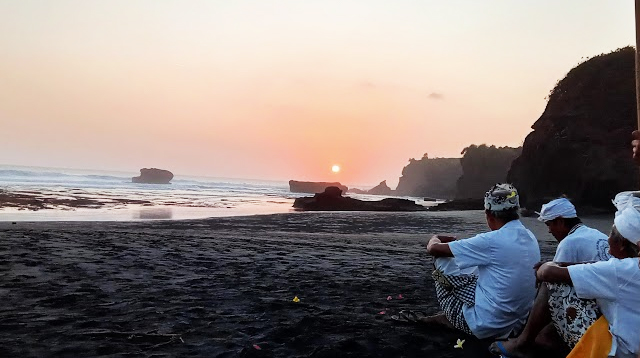WHEN the sun dips below the horizon, casting a warm, golden glow over the serene coastal landscapes of Bali, a centuries-old tradition unfolds. The Melasti procession, a deeply spiritual and visually stunning ceremony, takes place against the backdrop of the setting sun.
In this article, we will explore the significance, rituals, and enchanting beauty of the Melasti procession during sunset time in Bali, Indonesia.
The Significance of Melasti
Melasti is one of the most sacred rituals in Balinese Hinduism, practiced to cleanse and purify the ritual paraphernalia, sanctified effigies, soul and the environment. It typically occurs several days before Nyepi, the Balinese Saka New Year, marking a period of reflection, renewal, and spiritual preparation. The term “Melasti” is derived from the words “mala” (meaning impurities) and “asti” (meaning to get rid of), symbolizing the act of purification.
Other than related to procession of Nyepi, piodalan or temple festivals are also accompanied with Melasti. All pilgrims, either children, adults or elderly participate in it. With full of devotion, they would like to purify themselves and get blessing from manifestation of God where the procession is held.
The Rituals of Melasti
Melasti involves the ceremonial procession of sacred objects, temple paraphernalia, and revered deities to the ocean or other sources of water, such as rivers and lakes. This procession is often carried out by pilgrims from local temples, wearing traditional Balinese attire and bearing colorful offerings, which are beautifully arranged in woven baskets.
Prayers and Offerings: The day begins with prayers and offerings at the temple, where priests lead the congregation in seeking blessings for the purification ceremony. Offerings of fruit, flowers, and incense are made to appease the deities.
The Procession: As the sun begins to descend, the procession begins its journey towards the nearest body of water. Pilgrims walk together, carrying the sacred objects atop their heads, surrounded by the mesmerizing melodies of traditional Balinese gamelan music and the rhythmic chants of priests.
Cleansing and Purification: Upon reaching the water’s edge, the priests lead the congregation in prayers and purification rituals. Pilgrims immerse the sacred objects and themselves in the water, symbolizing the cleansing of their souls and the removal of impurities.
Blessings and Gratitude: After the cleansing ritual, offerings are made to the spirits of the sea to seek their blessings and protection for the year ahead. Pilgrims express their gratitude for the abundance and beauty of the natural world.
Sunset and the Melasti Procession
The timing of the Melasti procession at sunset is intentional, as it adds a profound layer of symbolism and visual magnificence to the ceremony:
Spiritual Connection: Sunset is often associated with a connection between the earthly and the divine. The warm hues of the setting sun are seen as a bridge between the physical and spiritual realms, making it a spiritually charged time for the Melasti procession.
Symbolism: The setting sun symbolizes the end of one day and the promise of a new dawn. Similarly, Melasti signifies the end of impurities and a fresh start in spiritual and moral life.
Aesthetic Beauty: The interplay of colors during a Balinese sunset, with its shades of orange, pink, and purple, provides a breathtaking backdrop to the procession. The reflective waters of the ocean enhance the visual spectacle, creating a serene and ethereal atmosphere.
The Melasti procession at sunset is not merely a cultural display but a profound spiritual journey that embodies the essence of Balinese Hinduism. It is a harmonious blend of tradition, devotion, and natural beauty, where the sun’s descent below the horizon symbolizes the purification and renewal of the soul.
Witnessing this sacred ritual against the backdrop of a Balinese sunset is an experience that captivates the senses and leaves a lasting impression of the spiritual richness of Bali’s culture.










